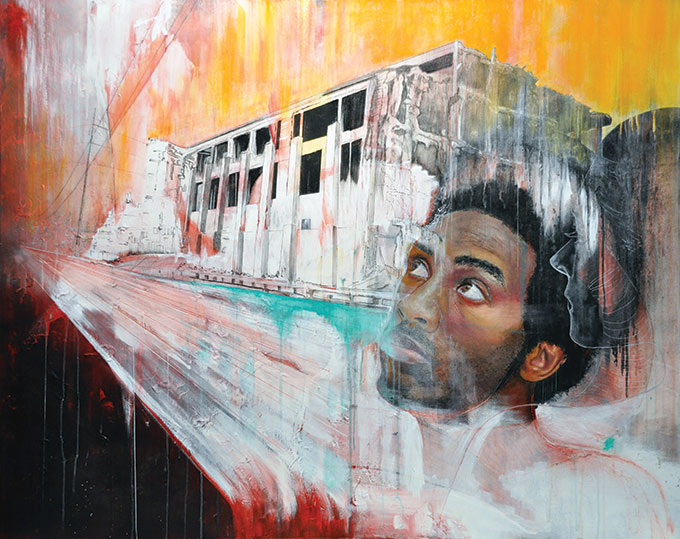Next story: Round 3, Week 2: Well Worn Boot vs. High Horse
Thomas Webb, Chuck Tingley, Max Collins, and OGRE at Hi-Temp Fabrication
by J. Tim Raymond

Gang of 464
Having just returned from New York City, I was already familiar with chilly freight elevators and factory loft spaces where art was concerned, but when I got off the lift, stepping into the freshly painted white brick Hi-Temp gallery space, I wasn’t equally familiar with the artwork there. Members of a stable of artists out of Gallery 464, the artists exhibiting are the most recently visible in a creative cooperative responsible for some of the most inventive public mural work seen around the city. Here they rein in their more effusive, not to say feverish, compositions for more direct and personal expression.
Thomas Webb’s black-on-white figuration examines the dark side of free will. These are strong, graphic, poster-sized works demonstrating various manifestations of “evil” in the pernicious conduct of human beings. By adding horns, tails, and gnashing teeth, Webb graphically emphasizes the interior under belly of the devil within us.
Chuck Tingley is perhaps the most accessible of this Gang of 464, notable for his immediately recognizable figurative art (a commercial style I associate with mainstream advertising illustrations of the late 1950s and early 1960s, people selling cigarettes, liquor, or holiday cruises) that consists at present of brisk and confident renderings of anonymous persons in various predicaments or preoccupations, often in interpersonal relationships. While these figures are professionally executed, the most striking aspect of Tingley’s best compositions are the surfaces he works his figures on: beat-up doors, window frames, slat wood pallet panels— utilitarian objects of long and wounded use. Gouges, scars, and evidence of hard and frequent abuse give his artworks a measure of emotional distraught.
At a right angle to Tingley’s exhibit is Max Collins’s series, No More Talking, large, individual, ink-jet printer portraits of young children in the thrall of electronic media. As Collins puts it, evident of “internet addiction,” depicting how even at an early age behavior is altered by the abiding dependence on digital tools. His subjects, lit by their computer screen, blankly stare into cyberspace, absorbed in a twilight realm of virtual reality. Before I read the accompanying text, I thought the children exhibited signs of post-traumatic stress.
OGRE’s contribution to the quartet occupies the far corner. Since the first announcement of his public personae, Matthew Grote (I hope I’m not outing anyone here) has created an ever-widening body of work, from spontaneous murals to posters, paintings, drawings, and sculptural installations. As OGRE, his work reflects his faux primitive musings on inspiration and a life well loved. In this exhibit he has painted portraits of his “fwends” and loved ones in an attenuated, exaggerated cartoon style that owes something to the phantasmagorical paintings of Peter Saul, Chicago’s “Hairy Who,” and an awareness of hallucinatory delicacies of what was once known as the Far East.
Despite the gradual chill of the gallery space, the opening of what is now known as a “pop-up” art show was attended with enthusiastic determination bolstered in no small part by a host of sweet and savory offerings of prolific confectioner Cori Wolff.
The show continues through the end of March
blog comments powered by Disqus|
Issue Navigation> Issue Index > v12n12 (Week of Thursday, March 21) > Art Scene > Thomas Webb, Chuck Tingley, Max Collins, and OGRE at Hi-Temp Fabrication This Week's Issue • Artvoice Daily • Artvoice TV • Events Calendar • Classifieds |









 Current Issue
Current Issue